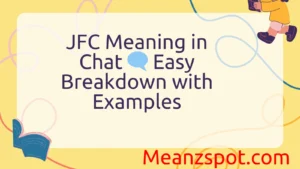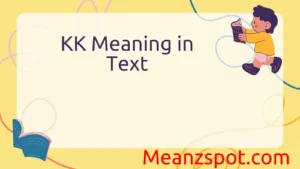Ever been in a chat and someone just replies with SMH? 🤔 If you’ve stared at your screen trying to figure it out, you’re not alone. In today’s world of text messaging and social media slang, abbreviations pop up everywhere, and knowing them keeps conversations flowing smoothly. SMH stands for “Shaking My Head”, and it’s used when someone feels frustrated, disappointed, or can’t believe what they’re seeing.
You’ll often find it in texts, TikTok comments, Instagram captions, and memes where people want to show disapproval or disbelief without typing a long response. In this guide, we’ll break down the meaning of SMH, share real-life examples, and show you exactly how to use it in conversations in 2025. 📱✨
Definitions & Meaning
SMH stands for “shaking my head.” It’s used to convey disbelief, disappointment, frustration, or mild disapproval without having to type out those emotions fully. Imagine someone hearing about something so ridiculous or frustrating that they literally shake their head — SMH captures that exact reaction in digital form.
For example:
- “He forgot his own birthday again. SMH.”
- “You’re seriously going to wear that? SMH.”
It’s a quick way to express a judgmental or facepalm moment, often lighthearted but sometimes with a sharper tone depending on context.
SMH is not used to literally describe someone shaking their head physically but more as an emotional shorthand to show exasperation or disbelief.
Origins & History
SMH started gaining traction in online communities and texting around the late 2000s to early 2010s. As smartphones and social media platforms exploded in popularity, users developed countless abbreviations to save time and fit their feelings into limited character counts.
The exact origin of SMH isn’t pinpointed to one source, but it first appeared in forums, chat rooms, and early social networks like MySpace and Twitter. Its rise coincided with a cultural shift toward more casual and playful online language, where non-verbal gestures had to be conveyed through text.
Interestingly, SMH quickly became part of mainstream pop culture. It’s been referenced in TV shows, memes, and even music lyrics, showing how deeply it embedded itself in modern communication. Today, it’s a recognized term across generations, though its use and interpretation can vary widely.
Usage in Different Contexts
Social Media
SMH is extremely popular on platforms like Twitter, Instagram, TikTok, and Facebook, where people react quickly to news, trends, or personal stories. Here, it often accompanies funny or shocking content, helping users signal their reaction without lengthy commentary.
Example:
“Someone just tried to microwave metal… SMH 😂”
Professional Communication
While SMH is common in casual conversations, it’s generally inappropriate in formal or professional settings because it can come across as too informal or disrespectful. However, some coworkers with a casual rapport might use it jokingly in group chats or internal emails.
Example:
“The printer broke down again. SMH.” (used among close team members but not in official reports)
Pop Culture
Celebrities and influencers use SMH to engage with fans, often reacting to scandals, bizarre events, or everyday fails. The term’s prevalence in pop culture helps maintain its relevance and popularity.
Common Misunderstandings & Clarifications
- Is SMH always negative?
Usually, yes, but it can be lighthearted or teasing rather than harsh criticism. - Does SMH mean “so much hate”?
No, this is a common misconception. SMH strictly means “shaking my head.” - Is SMH an abbreviation or an acronym?
It’s an acronym — it’s formed from the first letters of each word in the phrase “shaking my head.” - Can SMH be used sarcastically?
Absolutely! Sarcasm is a common tone when using SMH, often exaggerating disbelief.
Alternatives & Synonyms
If you want to express the same sentiment but switch up your texting style, here are some alternatives:
- Facepalm — Explicitly shows frustration or disbelief.
- SMFH — “Shaking my freaking head,” a more emphatic version.
- SMDH — “Shaking my damn head,” similarly stronger in tone.
- OMG — “Oh my God,” often used alongside or instead of SMH for surprise.
- Ugh — Simple expression of annoyance or frustration.
- Rolling my eyes (emoji 🙄) — Visual way to show the same reaction.
Each alternative carries a slightly different vibe — from mild annoyance to stronger disapproval.
Frequently Asked Questions (FAQ)
1. Can SMH be used in texting with older generations?
Yes, but some older people may not understand it right away. It’s best used with those familiar with internet slang.
2. Is SMH considered rude?
Not inherently. It depends on tone and context. Used in a friendly way, it’s usually harmless.
3. Can SMH be used in voice messages or calls?
No, it’s specific to text-based communication as it describes a visual gesture.
4. How do you pronounce SMH?
People usually say the letters individually: “S-M-H.”
5. Is SMH used globally?
It’s most common in English-speaking countries but recognized worldwide due to the internet.
6. Can SMH be misunderstood?
Yes, especially if the recipient doesn’t know the acronym or interprets it as rude.
7. Are there emoji equivalents to SMH?
Yes, like the facepalm emoji 🤦 or the rolling eyes emoji 🙄.
Conclusion
SMH is a simple but powerful acronym that captures a range of emotions, from disbelief to mild frustration, in just three letters. Its widespread use across social media, texting, and pop culture shows how digital communication continues to evolve with new shorthand expressions. While it’s mostly casual and informal, understanding SMH helps you interpret online conversations more accurately and use it effectively when expressing your own reactions.
Whether you’re shaking your head at a silly mistake or just playfully teasing a friend, SMH remains one of the most recognizable and relatable acronyms in the digital age. Next time you see it pop up in a message, you’ll know exactly what it means—and maybe even feel a little less inclined to shake your head yourself!



